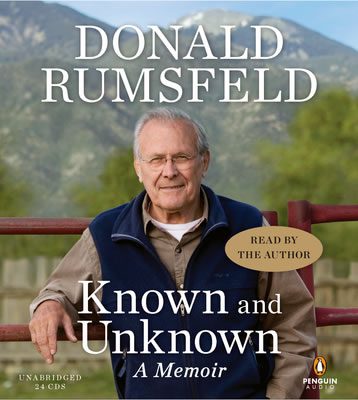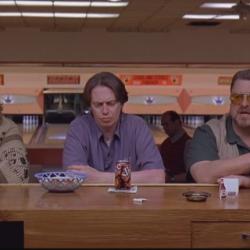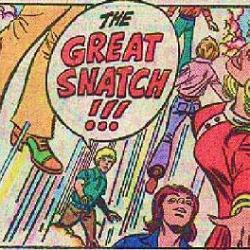Nicolae: The Rise of Antichrist; pp. 165-174
This chapter offers scenes featuring Rayford Steele at his Rayfordiest.
He and Hattie Durham are at a restaurant. That gives Rayford another chance to interact with people who are at work, and whether that’s at a restaurant, an airport, a store or a traffic stop, it’s an opportunity for more cringe-inducing Rayfordishness:
They were led to a table set for four. But even though two busboys hurried out to clear away two sets of dinnerware, and the waiter pulled out a chair for Hattie while pointing Rayford to the one next to her, Rayford was still thinking of appearances. He sat directly across from Hattie, knowing they would nearly have to shout to hear each other in the noisy place. The waiter hesitated, looking irritated, and finally moved Rayford’s tableware back to in front of him. That was something Hattie and Rayford might have chuckled over in their past. …
To fully appreciate the Rayfordosity on display here, keep in mind that this isn’t just any restaurant. This is Hattie’s restaurant. “Hattie herself had helped conceive it,” we are told. Rayford knows this, but — despite several pages of small talk in this chapter — he never says anything to her about it. No comments or compliments on the decor or the place’s success. No questions conveying an interest in her project. No acknowledging her work at all.
Most of us, on visiting a restaurant with an acquaintance who helped design the place, would find something encouraging to say about it, even if the place was a total trainwreck. “You must have had fun bringing all this together,” or some other such vaguely positive comment would seem like the least one should say. Hattie’s Global Bistro, we’re told, is doing very well. It’s a magnet drawing discerning patrons who have come from all over the world to work in the new global capital city.
Yet it never occurs to Rayford to say one word about it. Instead, within five minutes of arriving he’s giving the waiters a hard time for no reason (“I’d prefer to sit here, please,” would have avoided the irritation he seems to have provoked deliberately), rolling his eyes as though visiting such a restaurant is an ordeal. And he imagines that Hattie would be “chuckling” over this behavior if she weren’t otherwise in a bad mood.
The irony is that Rayford’s appalling behavior stems from his “thinking about appearances.” His aim, on arriving at the restaurant, was to appear virtuous — and he seems to believe he succeeded at doing so. He and the authors both seem wholly unaware that the main appearance he is creating is that of being a callous, condescending jerk.
That gets at the core of what it means to be Rayford Steele: the vast chasm between how he imagines he appears to others and how he actually is. That difference is a product, in part, of the fact that he seems to spend a great deal of time preoccupied with imagining how he appears to others and of the related fact that he is terrible at doing so accurately.
Consider this part of his conversation with Hattie, where he seems to think that imposing a lawyerly control on the terms of their former flirtation is a better way of asserting his goodness than, say, the long-delayed apology Hattie deserves from him:
“Well, to tell you the truth, when you dumped me –”
“Hattie, I never dumped you. There was nothing to dump. We were not an item.”
“Yet.”
“OK, yet,” he said. “That’s fair. But you have to admit there had been no commitment or even an expression of a commitment.”
“There had been plenty of signals, Rayford.”
“I have to acknowledge that. Still, it’s unfair to say I dumped you.”
One of the things that I find fascinating about Rayford Steele is the way he subverts the readers’ expectations about the significance of a character’s motive. Broadly speaking, we expect good characters to have good motives and evil characters to have evil motives. That’s a conventional way of distinguishing between the heroes and the villains of a story. Rayford doesn’t fit into such tidy categories. He has horrible motives, but he seems to believe — sincerely — that his motives are good. He’s a bad guy who thinks he’s one of the good guys, a cad who thinks he’s a gentleman, a jerk who thinks he’s a mensch, a negligent bystander who thinks he’s a hero.
This also separates Rayford from antihero protagonists. Antiheros may spend time “thinking about appearances,” but they tend to be aware of the difference between the appearances they strive to project and the characters they actually are. Antiheroes tend to be aware of their own conflicted motives.
With an antihero, redemption is always a possibility. Think of Tony Soprano. One could argue that the theme of The Sopranos was that Tony knew he needed to change to become a better person, and he even seemed to want to change to become a better person, and yet at every opportunity he chose not to. The show would have been a stagnant, repetitive mess except that Tony was perpetually aware of his need for redemption, of the possibility of choosing it, and of the cost of that choice.

Rayford is not aware of any of that. He thinks of redemption only in the past tense. Where The Sopranos gave us an antihero struggling, and failing, with the ever-present possibility of redemption, Left Behind gives us a Rayford, a man so wholly entombed in his delusion that he can’t even imagine changing or choosing or growing.
Whenever I think about this, trying to plumb the bottomless depths of Rayford’s shallowness, I’m tempted to think of him as a remarkable literary creation. He epitomizes the kind of delusional narcissism that enables one to enable evil. There are layers of complexity to his simple-minded self-absorption. Had any of that been a deliberate effect intended by his creators, these books might be read in literature classes. Jerry Jenkins — despite his shortcomings as a stylist, his tin ear for dialogue, and his delirious disregard for continuity and research — might be spoken of in the same sentences as Nabokov or Dostoevsky or, at least, David Chase.
But we don’t commend the authors for this achievement because they seem as wholly ensconced within Rayford’s delusion as Rayford is himself.
It almost seems unfair that such an accidental, unintentional achievement isn’t recognized. I suppose that’s partly because such accidents are all too common. Consider, for example, the polar opposite appreciation and literary reputation of Lolita and Known and Unknown. Both books feature an unreliable narrator desperate to charm the reader into forgiving the unforgivable by weaving a tapestry of self-serving rationalizations. Both narrative voices are a painstaking construct — the product of labor and artifice. Yet the former book is hailed as a masterpiece and one of the greatest novels of all time while the latter collects dust on remainder tables as an unwelcome relic from a time most of us prefer not to remember.
But imagine if “Donald Rumsfeld” was a wholly imaginary character and that the events recounted in his memoir were audacious fiction, a wicked satire describing an implausible campaign of deceit that ultimately ensnared even the deceivers themselves, leading to a catastrophically lethal blunder in which trillions were squandered and hundreds of thousands slain. Yet despite that all-too-predictable outcome, this fictional narrator with the oddly Dickensian name is unrepentant, effusively praising himself as a hero and a champion of virtue. If it were fiction — the product of conscious artifice rather than of unconscious artifice — Known and Unknown would be on the syllabus of English literature classes everywhere.
Now imagine the other side. What if Lolita was actually a memoir, written by a real-life Humbert Humbert? All that gorgeous prose would be reviled and rejected. Copies of the book would sit, unwanted and unread alongside copies of O.J. Simpson’s If I Did It.
Rayford Steele is, in his own way, a literary achievement that ranks up there with Humbert Humbert and the Underground Man, and with “Donald Rumsfeld” and “O.J. Simpson.” But because, like those last two, Rayford was not a deliberate artistic creation, he isn’t celebrated as such.
I don’t want to celebrate Rayford, but I do want to learn from him. He has a great deal to teach us. And so do his creators.
That, more than anything else, is why I’m still reading these books after nearly 10 years (!) of slogging through them page-by-ludicrous-page.
I’ve seen this referred to as “hate-reading” — analogous to the diversion of “hate-watching” so-bad-it’s-good TV shows or movies just for the fun of mocking their shortcomings and reveling in their failures. I appreciate the pleasures afforded by this pastime. It can be a lot of fun in small doses — especially in the company of quick-witted friends.
But hate-watching for its own sake can’t be sustained very long before it turns into something else. The whole point of the exercise isn’t just to absorb the awfulness of some so-bad-it’s-good movie or show, but to respond to it. And that response leads to something richer than just quips and mockery.
Just responding, “This is bad,” is unsatisfying. It lacks specificity. To get more specific — to identify and articulate that specificity — means switching from statements to questions. Why is this bad. How is this bad?
And that, in turn, leads to bigger questions: What is the nature of badness in general? What is the precise nature of the precise badness we’re witnessing here? What, if anything, would make this good? What is the nature of goodness?
These questions are not asked explicitly or didactically — that would ruin all the fun of getting together with your friends to watch Plan Nine From Outer Space or The Real Housewives of New Jersey. But such questions are also unavoidable if you want to say anything funny, clever or incisive. Without considering those questions on some level, you’d be left with nothing but puns and funny noises. (Not that I’m opposed to puns and funny noises — I still giggle at this YouTube classic starring Robert Tilton. But we surely there are also more substantial critiques that need to be made of Tilton’s brand of deceitful, predatory sanctimony.)
Even if you only start asking such questions in order to sharpen the edge of your mockery, thinking about such questions leads you beyond mere hate-watching and into something more like what we could call apophatic criticism.*
“Apophatic” is a fancy word from the world of theology. It usually refers to a kind of negative theology in which we strive to clarify the nature and character of God by saying what God is not like. The idea was put forward by folks like Maimonides and Dr. Seuss (“the way to find a certain something is to find out where it’s not”).
The idea of “negative theology” sometimes gets a negative response because the word “negative,” of course, has negative connotations. So some people hear that word “negative” and assume that negative theology must involve destruction — a tearing down or a tearing apart. But it’s actually a helpful approach that yields positive results. Negative theology allows us to be more constructive — to speak with greater clarity and confidence about the nature of God than we are able to do when attempting to make “positive” statements, which tend to be inadequate, anthropomorphic, or limiting and, therefore, misleading.**
That apophatic principle from The Cat in the Hat is what allows us to learn so much from the World’s Worst Books. These books are an almanac of awful — an exhaustive catalogue of “where it’s not” that enables us to better locate many certain somethings. These books fail on every level — storytelling, characterization, continuity, theology, politics, ethics, logic. They’re also clearly “so-bad-they’re-good,” and thus suitable for the amusement of hate-watching, but more than that, they are instructively bad. Every page provides an opportunity to ask all those questions above — an exercise in negative theology, or negative literary criticism, or negative ethics.
We can learn, in other words, how not to do theology, how not to tell stories, how not to treat others.
This is the value of contemplating Rayford Steele in all of his insufferable, overwhelming Rayforditude. Rayford serves — albeit unintentionally — as a flashing red danger sign warning us of the perils of delusional narcissism. He is worth studying and contemplating in the same way that Charles Sheldon taught us to contemplate Christ. “What would Jesus do?” Sheldon famously asked. And we can ask — just as fruitfully — “What would Rayford do?”
The difference there, of course, is that we should then make sure we’re not doing it.
If you’re a storyteller and you’re trying to write a story with an actual hero, ask WWRD? Then write the opposite.
If you want to be the hero of your own story and of your own life, ask WWRD? Then do the opposite.
Try it out next time you’re at a restaurant and the waiter comes to your table. WWRD? Do the opposite. You’ll make one person’s day and help to make the world a better place.
– – – – – – – – – – – –
* We shouldn’t make too much of this distinction between “hate-watching” and what I’m describing here as an “apophatic” approach. Don’t conclude that the former is frivolous or that the latter is ponderous. The whole point of hate-watching, after all, is to say something funny — and that means to say something true. So the real difference here may be something more like the difference between poetry and prose.
** This is part of why so many of my favorite bloggers are atheists — and why I often find myself agreeing with what they think and write about God. We can agree on the statement “God is not X,” even if we still disagree on the shorter, more sweeping statement, “God is not.” The atheist channel here at Patheos features several really excellent apophatic theologians.












